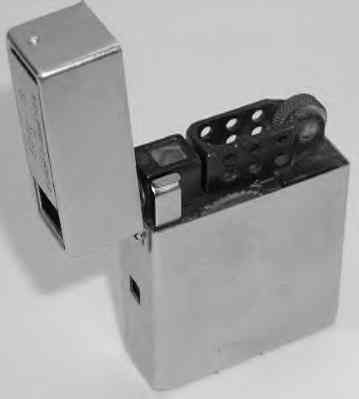
Suzuki Optical Echo 8
After World War II, the Japanese camera industry was coming out with smaller
and smaller cameras -- partly to keep costs low. First, they split
35mm film and produced Hit film (17.5mm). Then they used 16mm film.
But why stop there? Why not 8mm film in a still camera? In
1951, Suzuki Optical designed a cigarette lighter with a built-in camera
using 8mm film. Or some would call it a camera with a built-in cigarette
lighter. Whatever. Despite its tiny size, it had a fixed-focus
15mm lens with variable apertures from f3.5 to f8.0. This is equivalent
to a 75mm lens in the full-frame 35mm format -- a short telephoto. Two
shutter speeds of B and I (1/50). The shutter speed and aperture are controlled
with tiny tabs under the lighter lid that are moved by a fingernail. The
camera produced a 6x6mm format on 8mm (split 16mm) film. It's hard
to believe, but the camera had a built-in waist-level-type viewfinder that
was accessed by popping up the lighter lid, sliding the nameplate-panel on
the lighter lid out of the way, and then looking down. You view out
at a 90 degree angle -- great for clandestine photography!. You can
identify this model by its square lens opening on the side of the lighter.
This camera was manufactured for the American market but never sold
well and was soon dropped from production. Much to the surprise of
the manufacturer, it soon became famous as the camera that was used in the
movie, ROMAN HOLIDAY, which premiered in 1953. Audrey Hepburn played
a princess who escapes her palatial confines to taste the street-life of
Rome. A reporter, Gregory Peck, discovers her identity and enlists
a photographer, Eddie Albert, to take some clandestine photographs of the
princess. He accomplishs this feat with his trusty Echo 8 cigarette
lighter/camera. Suzuki Optical, the manufacturer of the Echo 8, was
caught completely off guard. With the free publicity that the movie
offered, and their own lack of supply, Suzuki could not keep up with demand
for the original model. To fill the gap, they opted to quickly come
out with a new, simplified, less-expensive version of the Echo 8, called
the Camera Lite in 1955.
COPYRIGHT @ 1995, 1996, 1997, 1998, 1999, 2000, 2001, 2002, 2003, 2004 by
Joe McGloin. All Rights Reserved.

